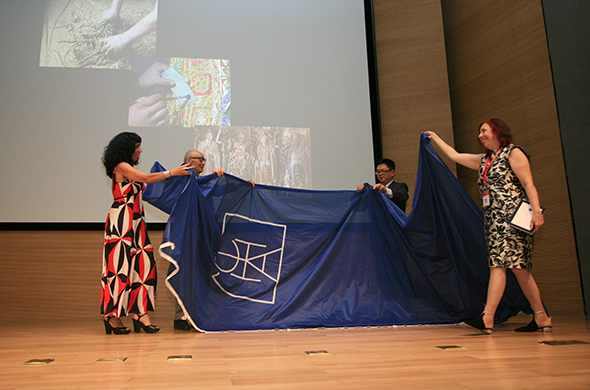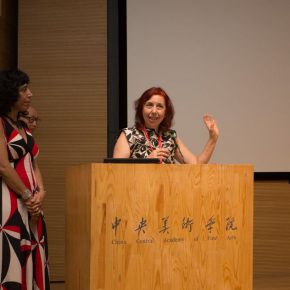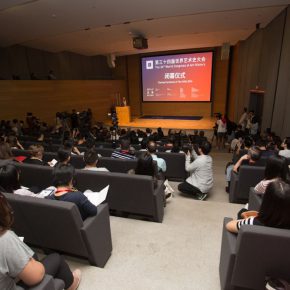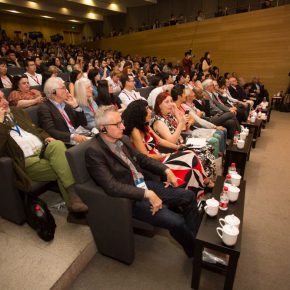
On the afternoon of September 20, 2016, the 34th World Congress of Art History which successfully lasted for five days closed at the auditorium of CAFA Art Museum, and the academic honored guests who participated in the congress attended the closing ceremony.
The 34th World Congress of Art History was jointly held by the Central Academy of Fine Arts (abbr. CAFA) and Peking University, divided into 21 sessions, including nearly 300 academic reports, more than 1,600 experts from 43 countries worldwide were able to participate in discussions and exchanges and there were nearly ten thousand spectators involved in the learning, thus reducing the distance between the discipline of art history and the public. In addition, the congress also organized 9 thematic lectures and 6 special exhibitions. The successful holding of World Congress of Art History does not only expand the thinking of Chinese art research, it also opens a new phase for the global pattern of art history. Director of Chinese Preparatory Committee at the World Congress of Art History, Prof. Shao Dazhen from CAFA presided over the closing ceremony.
The new Chairman of the CIHA, Prof. LaoZhu from Peking University delivered a keynote speech entitled “Future of Art History” for the closing of the congress, he said that, we have used images and material substances to study art from the past to the current day, although this practice is growing, it has been slowly weakened. Today we arrive in the era that uses images to depict society and reality, such as movies, VR, AR. He hoped that the future of art history was not going to be a weak discipline following linguistics and humanities and there would be learning that was capable to lead to the core of the image of the times, opening a new world.
Both displayed in CAFA, the “Smashed and Reassembled: Ancient Buddhist Sculptures from Longxing Temple in Qingzhou” and “Sculpture with Chinese Color: Research and Continuation of Shanxi Ancient Color Sculpture” were two special exhibitions for the 34th World Congress of Art History. These present another visual feast of art to the guests and audiences. Exhibition curator, Prof. Zhen Yan from CAFA introduced the details of both lectures to the guests of the congress at the closing ceremony.
Buddhist sculptures from Longxing Temple in Qingzhou were discovered in a cellar in 1996 which triggered the attention of academia and became a hot topic of research. The exhibition focuses on the original state of the statues when they were found and the relationship with complete statues, it also exhibits partially unearthed fragments, which were produced by 2 demolishing movements of Buddhism – Emperor Wu in Northern Zhou Dynasty and Emperor Wuzong of Tang who demolished Buddhism. The planning of the exhibition also intended to inspire people to start from Chinese culture to understand the meaning of art. When rethinking the concept of traditional “sculpture”, exploring the possibilities to establish an association between traditional art and modern art in form and concept.
“Sculpture with Chinese Color: Research and Continuation of Shanxi Ancient Color Sculpture” is based on the status of teaching the specialty of sculpture of CAFA. Shanxi is the best place to preserve ancient architecture and sculptures in China, while the Department of Sculpture focuses on learning from the traditional and the show presents the achievements of their research, investigation and teaching. The exhibition consists of three parts: the debris of ancient colored sculptures, the facsimiles of ancient classical colored sculptures, from which an understanding and refinement of the re-creative works happens. It presents both the magnificence of the ancient colored sculptures and also reflects on how ancient art changed to cultivation, and transformed into a new creation.
At the closing ceremony, a handover ceremony of the World Congress of Art History was also held, Prof. Shao Dazhen from CAFA and Vice President of Peking University Li Yansong together handed the flag to the representatives of the next host countries of the World Congress of Art History Marzia Faietti and Claudia Mattos. The 35th World Congress of Art History will be held in Florence, Italy and Sao Paulo, Brazil from 2019 to 2020, which will be the first time for the CIHA to hold a congress in both countries, promoting the World Congress of Art History to a more international perspective.
Finally, the former Chairman of the CIHA, Director of National Museum of Germany Prof. Ulrich Grossman announced that the World Congress of Art History was successfully concluded.
Text by Zhang Wenzhi, Photo by Yang Yanyuan/CAFA ART INFO
Translated by Chen Peihua and edited by Sue/CAFA ART INFO





































